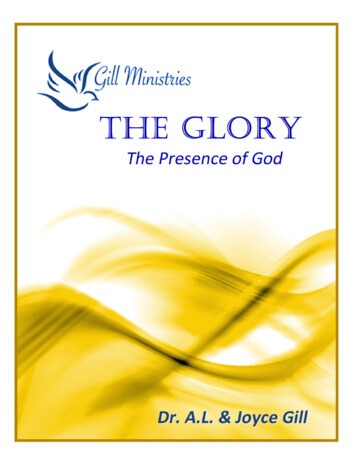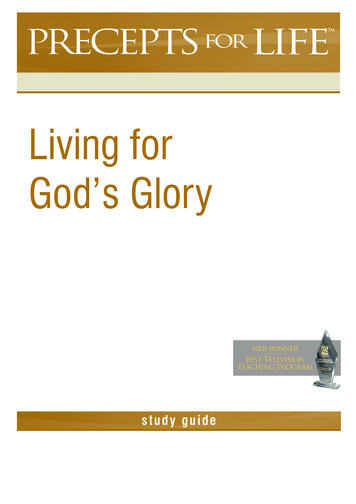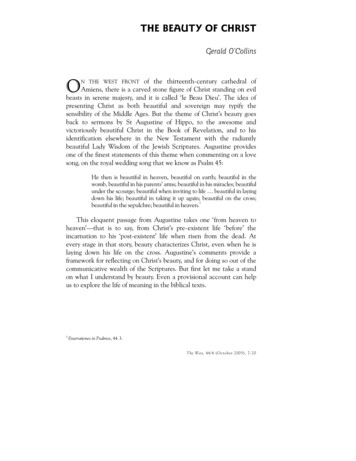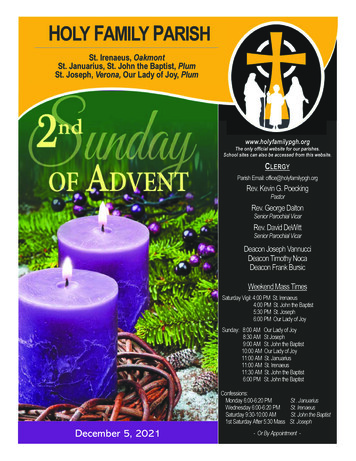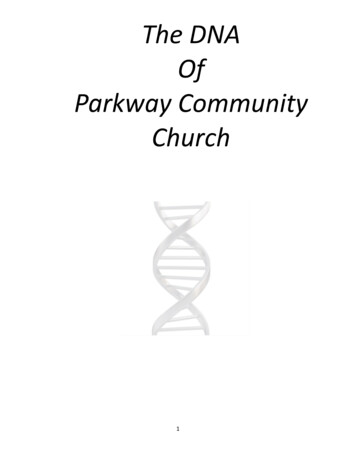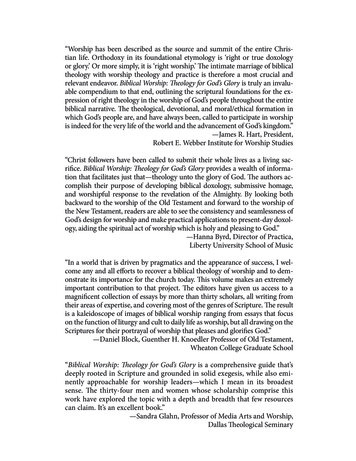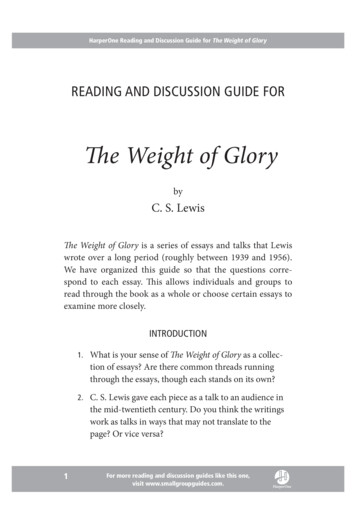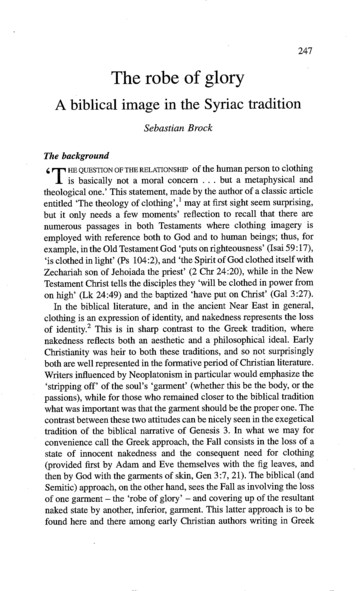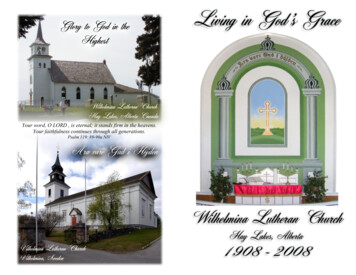
Transcription
Glory to God in theHighestLiving in God's GraceWilhelmina Lutheran ChurchHay Lakes, Alberta CanadaYour word, O LORD , is eternal; it stands firm in the heavens.Your faithfulness continues through all generations.Psalm 119: 89-90a NIVÄra vare Gud i HöjdenWilhelmina Lutheran ChurchHay Lakes, AlbertaVilhelmina Lutheran ChurchVilhelmina, Sweden1908 - 2008
This is what the Lord says—Israel’s King and Redeemer,the Lord of Heaven’s Armies:This was the message which the angels proclaimed to theshepherds on the hills of Judea when Jesus was born.This is the message which has been proclaimed from the"hills of Wilhelmina" for the past one hundred years.“I am the First and the Last;there is no other God.Who is like me?Let him step forward and proveto you his power.Let him do as I have done sinceancient times when I established apeople and explained its future.Do not tremble; do not be afraid.Did I not proclaimmy purposes for you long ago?You are my witnesses—is there anyother God?No! There is no other Rock—not one!”-Isaiah 44:6-8 NLTMay these days be a reaffirmationof our faith and trust in God as welive out our lives in God’s graceand bring"Glory to God in the highest".We gratefully acknowledge Burgar Funeral Home for the printing of thesebooks, and for donating the monument marking 100 years of God’s faithfulness.Please visit our website at www.wilhelminachurch.ca
the floor boards to my first nerve-racking climb to the top of the steeplewhen I was sixteen (which was just before the 90th anniversary celebrationand Algot had rebuilt the steeple steps. My mom tells me the old ladderswere really scary). Now I can climb to the top of the steeple with ease, andhave given tours to many others as well. The view is beautiful and everytime I look at that 576 lb. bell I marvel at the work it must have taken tohoist it up there so many years ago. I’d love to hear that story. Come to thinkof it, Dale even gave me our engagement ring at the top of the Wilhelminasteeple! I have been at the church at all hours of the day and night (thanks toa night job I held for a time after finishing high school). I love Pastor Craig’sdescription of “thin places” - indeed that has been my experience. Here, atWilhelmina, the Holy Spirit and presence of God is so close and that is whyI love it best. Here I can really talk with God. I have spent ever so manyhours playing the piano on my own or kneeling in prayer at the altar of Wilhelmina. I treasure every moment of that “mystic sweet communion” as anold hymn writer once wrote. Though I know that the Lord is not the building, I also fear the loss of the building - for it is here that I have most closelyfelt the presence of Jesus. The people of Wilhlemina have been my family and having just completed a study on our Lutheran Swedish Heritage whichPastor Greg led, I have a greater appreciation and understanding of why the“family” element of Wilhelmina is so important. It is “family” that was soimportant to our early pioneers, and that legacy still remains today. Throughstruggles and stresses and our imperfect human natures, we still want to be afamily and live together in unity with Christ and with one another. What anamazing gift and blessing we havebeen given. It was my Wilhelminafamily - Richard and Evelyn Pearson, Ed and Muriel Holdworth, Algot Person and so many more - thatgave me support and encouragement when I was growing up justby being there. I could fill a bookon my own with memories of choirpractices, services, potluck lunches,Sunday School activities and oh somany more things but I think I’vegiven you just a glimpse of myown small sliver of experience. Ihope that you will be blessed by it,and I pray that in your own livesthe Lord will continue to bless youand your families as you growcloser to Him.- Deanna Margel (née Matson)Interior of the belfry56Pastor’s MessageDear Christian friends – the Lord be with you.The old Romans had MILE STONES alongtheir hi-ways indicating the miles to travelfrom one place to another. When you travelin countries occupied by the Roman Empire,you will see these mile stones still standing.This year you have reached MILESTONENo. 100 on your congregational hi-way. Ifwe say it fast, it does not seem to be so longago. But when you walk life’s hi-way oneyear after another it is quite a long stretch. Youdo not see the end of it, or what kind of an end itmay be.Greg Kjos 2008But when you get to this distance – 100 years - 36, 525 days – together werediscover how fast the time has gone and how short the road really is. Furthermore we also discover that the congregation, which started in 1908, nowlives in the dawn of the 22nd century.Therefore when I was asked by the Anniversary Committee to provide a reflective word, I searched around in my mind, my heart and the Scriptures asto what the Lord says to us on this memorable occasion.My attention was drawn to Prov. 3:6 Now this verse is translated severalways. In the KJV, we read: “IN ALL THY WAYS ACKNOWLEDGE HIMAND HE SHALL DIRECT THY PATHS.” In free English, this verse istranslated by the following: “Have God in MIND WHATEVER YOUPLAN TO DO/AND HE WILL GUIDE YOU IN THE RIGHT WAY.” Orput another way, this same verse is echoed in Ps. 37:5 “COMMIT YOURWAYS UNTO THE LORD AND HE SHALL BRING IT TO PASS.”These words are in sharp contrast to our present day attitude and life stylethat reflects our desire to get our own way and to live our life according toour plan. Yet Wilhelmina Lutheran’s presence is a vivid and lucid reminderthat life – especially the Christian life, a life lived and celebrated withincommunity - is about Jesus and living life according to His plan and His1
way. Jesus says: Without ME you can do nothing (John 15). Nothing of realand lasting value. And so life ends for so many in a tragic way.As we celebrate this day and also gaze into the days ahead, who (not what)is our hope based on? It is based on a faith conviction that affirms the livingpresence of Jesus and a living faith in God: Father, Son and Holy Spirit.Therefore I encourage us to keep looking to Jesus, who is the pioneer andperfector of our faith so that we may continue our race which is set beforeus, a race established and planned by Jesus and set before us for His gloryand our wellness.In all your ways and plans have God in mind and He will lead you the rightway and to everlasting blessed eternity.- Pastor Greg KjosPRAYER:We thank Thee, Heavenly Father for all the blessings Thou hast showeredso abundantly upon this church family. Thou hast granted them grace towalk together life’s road the past 100 years. Keep on leading them the restof their lives. Bless them in Jesus richly and all their loved ones. Amen2In Closing.Well, two years passes very quickly. When Ronand I undertook updating the history book, itseemed we had so much time.now all of a suddenwe’re down to the final few days. I often laughedabout updating this book - 25 years ago I was nineyears old - and until about seven years ago livedquite unaware of the nuts and bolts operation ofthe church. Without the help of the congregation,this update would not have been possible. I amespecially grateful to Ryan and Lillian Nordin whohave been keeping track of dates and activities through photos and scrapbooks, and Ed and Muriel Holdsworth who helped out with the “To Reminisce” section. Ron has done a ton of reading through old minute books tosearch out names and dates, and he’s handled all of the work pertaining tothe actual printing of the booklet. I am very grateful.Names and dates are good, and important, but I have been most excitedabout the addition of this “Our Memories” section. Here are the stories ofthe people and that’s the part I like best. I have enjoyed reading the submissions we’ve received, and I hope that all of you will too. It’s been fun to readthe stories of people I know (and some that I don’t). I’ve been fascinated byhow things were different and amazed at how they are the same. I’ve discovered some really interesting things: “You mean the congregation really splitover the location of the church when all the possible locations were less thana mile from each other?!!” I guess travel by horse and wagon made a bigdifference, but it just seems strange to me one hundred years later. I am gladthey built where they did, though - I can’t imagine the church in any otherlocation. I really had to laugh when I discovered the fans had been installed14 years earlier and the council was still debating the issue when I waschairperson - and council did share many wonderful moments of merrimentover those discussions. I was fascinated by the different perspectives I heardabout Algot - whose name, in my memory, is nearly synonymous with Wilhelmina since he was always up at the church cleaning and working and justbeing there. To hear him described as one of “the big boys” who used to sitat the back of the church ‘intimidating’ to the younger kids made me realizehow small my own perspective was - that here was a person who had alreadylived much of a lifetime before I was even born. And how true that is for thechurch and the lives that it has touched - my own little slice of experience isso small in that hundred year span.I do, however, have a host of wonderful memories of Wilhelmina - from laying on the floor beneath the pews as a child and tracing the cracks between55
al was cloudy and cold with the threat of more snow, with several inches onthe ground already. I don’t remember anything about being in the church orthe service, but clearly remember the bell ringing, a large number of peopledressed in black or dark coloured clothes, gathering around the grave, somewere crying and holding on to each other, all shivering in the cold. That’s it,all I remember.Until we moved to a farm near Miquelon Lake in May of 1966, I had no further involvement with Wilhehmina Church. I became involved when thechurch was reopened in early 1967, and have been attending ever since. Being part of the congregation also called for participation on the team responsible for care and maintenance of the cemetery. The cemetery “crew” as itwas sometimes called, consisted of nearly all members of the congregation,both men and women at one time or the other. Grass cutting time usuallyhappened in the evening after supper; sometimes many would come, sometimes a few, but always there was intense activity for a couple of hours aslawn mowers and grass trimmers roared away until the cemetery was manicured and presentable for another couple of weeks. If the mosquitoesweren’t too bad, we usually stood around talking and reminiscing for halfhour or so before returning home. What great times! Over the last few yearsone becomes aware that many who participated on the work crews are nowthemselves resting peacefully in the cemetery at Wilhelmina, able to rest,knowing that there will be a new generation prepared to carry on the tradition. Over the past forty years I have received great pleasure and satisfactionbeing part of this service to our congregation and community. As one travelsback and forth over the graves, reading the names and dates on the headstones, many were neigbours and friends, for me others are just names.Many questions come to mind, especially for the infants and young oneswhose life on earth was so short. Who were they? What happened? I’ll neverknow their story; I will always be wondering and never have the answers.One thing is for certain, the scriptures say, “I knew you before you were knittogether in your mothers’ womb;” and “the Father knows the number of hairgrowing on your head.” So even if I don’t know their story, their story iswritten in the Book of Life and preserved for eternity.While the Wilhelmina Church cemetery has received loving care and attention for nearly one hundred years, what is in store for the future no personknows. One can only speculate: maybe it will carry on as is for another hundred or maybe five hundred years, or, maybe one day be marked only by aplaque or monument and cared for by some committee or the state. It is alsopossible, as memories and history dim over time, nature will reclaim what itgave up some one hundred years ago. We may not know, but our Lordknows and He will never forget.- Ed Holdsworth54IntroductionThe history of this congregation is typical of many, for it was conceived inprimitive, pioneering conditions and has continued through the years,through storm and sunshine, poverty and prosperity. People have come andgone, many gave years of outstanding service in various capacities, out oflove for the Lord and without any thought of personal glory. Let us honorand give thanks to God and His church, for the ministers and pioneers of thiscommunity, who nobly sacrificed so much in order that they and the generations thereafter would have a place to worship, to teach the word of God, tobaptize, to marry and to bury their loved ones.The history was compiled by Mr. John Erickson for the Fiftieth Anniversarycommemorated in the year 1958. Every effort to ensure the accuracy of thispublication has been made, but with the passing of time and the death ofmost men and women who were associated with the settlement of the community and the establishment of the congregation, it becomes more andmore difficult to obtain accurate information. Many thanks to Mr. Ericksonwho was commissioned by the congregation. With his permission this history was revised and updated by Alver and Algot Person for the seventy-fifthanniversay in 1983. To commemorate the 100th anniversary of the congregation in 2008 the existing history was again updated, this time by Ron Eliason and Deanna Margel, to reflect the experiences and changes of the churchbuilding and congregation between 1983 and 2008.For a number of years during the turn of the century in 1900, there was ageneral exodus of the people from the Scandinavian countries to America.They were hardy, ambitious people, filled with a spirit of adventure and unmatched courage. The Canadian Pacific Railway had been completed fromEastern Canada to the Pacific in 1885, thus opening the west to the settlement of millions of acres of farm land. The Government of Canada andthe railway launched a campaign designed to bring thousands ofimmigrants to this land. Hundreds of thousands of pamphlets, maps andfolders, printed in English, German, French, Dutch, Danish, Finnish, Norwegian, Swedish, Welsh and Gaelic were distributed throughout the countriesof Western Europe. This literature gave glowing and exaggerated accountsof tremendous opportunities in the Canadian West. And it told of low pricedland which could be had for the asking. Enticed by this type of advertising,and letters from friends who had emigrated earlier, many decided to leavethe land of their birth, their homes, friends and relatives to try their fortunesin a new and foreign land, the Canadian West.3
In the year 1900, Mr. And Mrs. Staboe and a lady friend (Inga Johnson),emigrated from their native Sweden to Minnesota, U.S.A. There, Inga metand married Jacob Lunde, who had previously left his Swedish homeland.Later on, the Staboes and the Lundes moved to Alberta, Canada and homesteaded in the area which became known as the Lundemo district, locatedabout thirty-five miles northeast of Wetaskiwin, the nearest railway pointat that time. Mrs. Lunde, who was well acquainted with the Selinsin Sweden, wrote to them, telling of all the wonderful prospects forthe future and the homestead land which was available. Axel Selin decidedto move with his wife, family and a brother, Petter, and they set out for theland of opportunity. After becoming settled the Selins wrote back to Swedento the Victor Erickson family, inviting them to come to Canada, which theydid. Within the few years that followed, many other families came over andbefore long the entire district had been settled.These pioneers arrived in this country with a few meagre personal belongings, odd articles of necessary clothing and had little or no money. Many ofthe men did off-season work in the timber lands of British Columbia or therailway camps, in order to provide a living and gather a few necessities oflife. The privation and hardships suffered in their struggle for existence weremany, but they were strong in their faith in God and had untold courage andambition. They had the spirit and will to work, progress and prosper, whichis reflected in the modern farms and fine homes which are in thecommunity today. The first houses and farm buildings were built fromhewed logs and home-sawn native lumber. Many of these buildings are stillin evidence, a tribute to the skilled workmanship of our early pioneers,a skill brought with them from the land of their birth. Much of the firstsod broken in this area was done with oxen and horses.During times of illness and childbirth, doctors and nurses were too distant tobe of much help in time of need, but the people of this district were mostfortunate to have in their midst a woman who, although not a trained nurseas we know them today, spent most of her life caring for the sick and lending a helping hand wherever it was needed. This woman was Mrs. MagnusLindberg (Mathilda). Like a doctor, she was ready to go when called andmany a night she had to set out with a team of horses in rain storms or thebitter cold of winter to help a neighbour in distress. She was an experiencedmidwife, and many of the people living here today were brought into thisworld with her assistance.***Not to us, O LORD, not to us, but to your name be the glory,because of your love and faithfulness. - Psalm 115:1 NIV4God's fellow workers who have used their gifts to bring glory to God. Excellent councillors; cemetery caretakers; the many members who have workedtirelessly to care for and maintain the beauty of the church building; treasurers, secretaries, musicians; Sunday school teachers; Willing Workers. Mostof all, God has graciously provided us with faithful Pastors who have taughtand preached His truth so that God’s love through Jesus and the power of theHoly Spirit is continuing to be fulfilled today.- Muriel Holdsworth (née James)A Church in Action, A Church at RestAnyone approaching Wilhelmina from the south will see a beautiful whitecountry church, framed with a border of green evergreen trees. When youdraw closer you’ll notice a particularly fine specimen of spruce tree, towering over the steeple and situated in the centre of the cemetery. I was told bythe late Ernest Nordin that it was planted near the grave of Edwin Olson in1937. It is hard to believe a tree could grow to such size in 70 short years,but it also doesn’t seem logical for the cemetery caretaker of the time, tohave allowed Andrew Olsons’ grave to be dug so near a well establishedtree. I guess we’ll never know for sure how old this tree is, as all the peoplewith that knowledge have probably passed on by now. But by just beingthere, it makes a wonderful and unique centre piece for the WilhelminaChurch cemetery.Pastor Bill Harder, former Pastor of Scandia/ St. Joseph Parish, describedthe Christian Community as being like a tree and consisting of two parts.The visible part is above ground and is comprised of the trunk, branches,leaves or needles; it is vibrant and full of life: or what he called the activechurch. The roots on the other hand are the invisible part of the tree, providing a solid foundation, a secure anchor, the source of nourishment, or what Iwill call the resting place of the Saints at Wilhelmina. So in this great treestanding solid and secure in the centre of Wilhelmina’s cemetery we have avisual symbol of our church. A church in action, a church at rest: proud ofour history, joyful in the present, anticipating our future, always in service toOur Lord and Saviour Jesus Christ.My first intimate contact with Wilhelmina Church was in late November orearly December of 1941, when my nephew Ryan Davidson, an infant, diedof a childhood disease, probably pneumonia. I do not remember anythingabout Ryan, as I was only four years old myself. But receiving the news ofhis death, my older brothers helping dig the grave, my dad and Carsten(Ryans’ dad) building a wooden box from rough sawed poplar boards tocontain the coffin and strapping it to the spare tire assembly of a 1928 car,are as vivid in my memory today as when it happened. The day of the funer53
God’s PlansMy earliest memories of Wilhelmina Evangelical Lutheran Church come byway of a phone call from one of its (past) members, Verner Johnson. In thefall of 1965, Ed and I along with our two small children were living in Edmonton but making plans to move a house onto our property at NW 8-4920-W4.In the fall of 1965 - under extreme resistance - the church had been closed.The phone call from Verner that fall was part of an effort by many membersof the congregation to have the church re-opened. He told us that he wasaware that we were planning to become his families' immediate neighbours.He gave a brief summary of the congregations desire to have the church reopened and invited us to make Wilhelmina our new church home. As far as Iknow, Verner didn't even know if we regularly attended a church; throughthe invitation Verner stepped out in love and faith and as a result here we aretoday!At the time, I certainly didn’t know what the future would hold, but Godknows all things. Jeremiah 29:11 says: “For I know the plans I have foryou,” declares the LORD, "plans to prosper you and not to harm you, plansto give you a hope and a future.” We are forever grateful to God for hisplans: The congregations' passion and efforts to have the church re-openedwere successful. The current congregation (and hopefully -future generations) will continue to be blessed with the privilege of joining together toworship our awesome God in this beautiful place. What a rich experience!My mind is flooded with so many memories of people, past and present;A New ChurchIn the year 1902, a congregation had been formed some ten miles to thesouth-east of the Wilhelmina community. This was known as the FridhemLutheran Church.1 In spite of the long distances which had to be covered byoxen and horses, many attended services there occasionally, and a few including the Axel Selin family were members. But these people had a visionof the future, for themselves and their children, that was responsible for thedecision that God's word must be planted in our midst. In the land that theyhad left behind, the church had played an important part in their daily livesand they felt that here too, there was a great need for a church. So on Saturday, the 7th of November, 1908, a meeting was called at the Erik VictorErickson home for the purpose of organizing a congregation. Pastor OlafLindgren, who had been serving the Fridhem congregation, was electedchairman of the meeting, with Axel Selin as secretary. Elected to the boardof administration were the following: Deacons - Nils Lindberg, Harold Person and Magnus Johnson; Trustees - Amandus Pearson, Linus Selin andMagnus Lindberg; Treasurer - Linus Selin. It was agreed to name thechurch the Swedish Evangelical Lutheran Wilhelmina Congregation. Manyof the early settlers who homesteaded in this little community had emigratedfrom Vilhelmina, Västerbotten in the northern part of Sweden, and so inkeeping with thememories of home andthe place of their birththey decided that it wasonly fitting to namethis new church"Wilhelmina". It wasagreed to join theMinnesota Conferenceof the Augustana Synod, and the constitutionof 1887 was formallyadopted.1It is of note that theFridhem LutheranChurch building wasdestroyed completelyby fire in the spring of2005.Original church blueprints525
Charter members were as follows: Mr. and Mrs. Axel Selin and family, Mr.and Mrs. Nils Lindberg and family, Linus Selin, Mr. and Mrs. Erik Hansonand family, Mr. and Mrs. Hans Erik Johnson and family, Mr. and Mrs. Harold Person and family, Mr. and Mrs. Gustaf Edvall Carlson and family, Mr.and Mrs. Jonas Amandus Pearson and family, Mr. and Mrs. Erik P. Nordinand family, Mr. and Mrs. Per Alfred Forsen and family, Erik Oscar Swanlund, Mr. and Mrs. Anton Pearson and family, Mr. and Mrs. JonasSandquist and family, Mr. and Mrs. Erik Victor Erickson and family, Mr.and Mrs. Petter Selin and family, Mr. and Mrs. Magnus Lindberg and family, Mr. and Mrs. Nils Magnus Johnson and family, and Per Olof VictorErickson. This made a total of thirty-three adults and forty-seven children,truly a remarkable beginning.Elected as a committee to investigate the possibility of building a church andfinding a suitable location were Oscar Swanlund, Anton Pearson and AxelSelin. Services were to be held in Swedish once a month in the varioushomes throughout the community with Pastor Lindgren officiating.The question of a suitable location for a church site and cemetery was considered at a special meeting, held at the P.A. Forsen home on March the 4th,1909. One location being on the Oscar Swanlund farm (SW 12-49-21 W4)and the other on the Magnus Lindberg farm (NW 12-49-21 W4). The trustees were given the authority to close a deal with either party if possible. Inthe meantime, Mr. Swanlund had decided not to part with any of his land fora church building, and instead of attempting to close a deal with Mr. Lindberg, the committee decided that a better location would be on the P.A.Forsen farm (SE 12-49-21 W4), where the church is now located. Considerable opposition to this move was expressed by the members living in thewestern part of the community as they felt that this would mean much farther for them to attend church.This matter was finally settled at a meeting held at the Victor Erickson homeon September 24th, 1909. The choice of a location on Magnus Lindberg'sland or on P.A. Forsen's land was carried by a motion to build a church onthe P.A. Forsen's, by a majority of two votes. The sum of 15.00 was paidto Mr. Forsen for the purchase of four acres of land, with the understandingthat the congregation pay for the cost of the transfer of title. However, dissension on this issue resulted in nine families separating from the Wilhelmina congregation to form their own congregation, the Swan Hill ChurchSociety.11St. Joseph Lutheran Congregation: 100 Years of Grace Centennial AnniversaryAugust 26, 20076I felt that four significant things happened.1. God spoke to this couple.2. They testified that God had told them to come to Wilhelmina this was an affirmation that God has a purpose for Wilhelmina.3. They were obedient to God’s instruction and came.4. They gave generously of their means - it wasn’t a casual dropping by.The following Saturday, I had the strongest urge to call the number againand I did. The young man answered after the first ring. I told him how theyhad been on my mind all week. I explained that there had been times overthe years when I struggled with discouragement. I stressed what an encouragement it was to me to know that God had sent them. I asked him:1. Could he tell me more about how God had spoken to them?2. Would they allow this information to be shared with the congregation?The answer to both questions was yes.He said he had been on his way to Camrose (Monday May 7), travelling onHighway 623, when he saw the sign for Wilhelmina Lutheran Church. Hesaid he was moved by God's Spirit and believed God was telling him to goto that church. So he turned off the pavement and drove down the gravelroad until he reached the church. When he returned home that evening, hetold his mother what had happened. He said “My mother is an Intercessor”.She prayed, asking God what He wanted them to do. She got the same message from God that the young man had; that He wanted them to visit Wilhelmina. The young man returned to the church alone on the Wednesdayevening of that same week, where he spent some time in the churchyardpraying before going into the church. He said he felt a strong sense of God'sHoly Spirit in this place and again felt that God was affirming that he andhis mother should return for worship on Sunday. He also said that he believed Wilhelmina has a good heritage--that this church was established forand has a purpose to serve God. He believes many Churches today havebeen born out of strife and that God needs churches that have the right foundation so that they can be a witness for Him to the world! The young mansaid he and his mother had a wonderful time worshipping with us. He believes God led them to Wilhelmina as an encouragement to us and insistedthat we recognize that this is the work of Jesus and not something they aredoing on their own.Editors Note: The young man and his mother came a couple of times thatsummer to worship with us, along with the young man's fiancé. The following summer they were married at Wilhelmina, with the Willing Workers catering the wedding reception.-Taken from a letter written to the congregation from Muriel Holdsworth.51
Visited By AngelsHebrews 13:2 Do not forget to entertain strangers, for by doing so somepeople have entertained angels without knowing it.At the morning worship on May 13, 2001 (Mother's Day) a woman and ayoung man joined us for service. The woman was more mature, but it washard to guess what the relationship between the two was. When I began torecord the offering (after the service) I was surprised to find along with thecheque I had received from the young man was another cheque, this onefrom the woman. Without breaking confidentiality I must admit that I wasvery surprised at the amounts.I believe that God's Holy Spirit revealed that there was something specialabout this visit, so I jotted down the phone number (Stony Plain) so that laterI could make a call and say thank you--and tell them how blessed we were tohave them visit us. When I dialled the number I got a voicemail recording.I left a message saying who I was and on behalf of the congregation I justwanted to say thank you for their generosity and that it had be
Glory to God in the Highest . Living in God's Grace 1908 - 2008. This was the message which the angels proclaimed to the shepherds on the hills of Judea when Jesus was born. This is t
